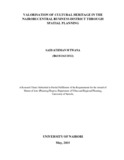| dc.description.abstract | Modernization, which is inevitable in every society, should not overshadow the importance of
cultural heritage as a vector of development and social stability, both for present and future
generations. Today, a number of traditional solutions to development, which are particularly
ingenious, deserve to be taken into consideration in the search for solutions to prevailing life
challenges. In order to preserve this legacy from the past, National and local communities are
encouraged to protect and valorize this heritage that represents the core of their common identity.
Today, more than ever, it is essential to better know and understand the richness and variety
present within African cultural heritage. In Kenya, the preservation of this heritage will only be
possible through the collaborative efforts of county governments that can appropriately legislate,
local communities, and the citizenry, who have the capacity to identify their own cultural heritage
that will remain coherent and relevant as long as it remains alive in the context where it originated.
This has not been the practice in Kenya as the importance of cultural heritage in the spatial
planning process tends to be sidelined or minimized with, at best, only certain classes of heritage
resources being made public as part of tourism planning processes.
In this work the valoration of cultural heritage within Nairobi’s Central Business District through
spatial planning has been investigated. The specific objectives of the study were to investigate the
extent of awareness of cultural heritage among local urban communities in Nairobi; explore how
knowledge and skills of cultural sites is transmitted to communities in Nairobi; identify the gaps in
planning and urban design that hinder the transfer of knowledge and skills on cultural heritage; and
recommend spatial planning interventions that will lead to increased awareness of cultural heritage
preservation of existing cultural heritage characteristics, and dealing with the gaps in policy and
practice that hinder the manifestation of cultural heritage in Nairobi’s CBD.
iv
The study established that urban communities are conscious of their heritage environment from
which they derive both material and intrinsic benefits. It also found out that there is absence of
deliberate planning for cultural heritage in the urban areas, thus exposing the existing cultural
heritage to risks of diminishing value, extinction or conversion to other uses. Important case
studies, such as the KwaZulu-Natal provincial government interventions in ensuring that their
cultural heritage is appropriately integrated into planning processes, as well as the work by the
Nairobi National Museums of Kenya in a village known as Shimoni in South Coast Kenya were
found to provide useful lessons for Kenya to adopt and adapt in ensuring that cultural heritage is
made part and parcel of planning processes.
It is concluded from that study that the opportunity to reclaim Nairobi’s degenerating cultural
identity, while increasing its revenue base through cultural heritage is of strategic importance
today, more than ever. It is therefore recommended that the Nairobi County Government sets out
relevant legislation and guidelines for the responsible management and sustainability of existing
cultural resources, and serve as a model for other county governments in Kenya. Introduction of
innovative and creative urban design solutions that valorise heritage sites, such as designing of
urban routes and cultural heritage corridors and the application of clustering and agglomeration
cultural typology is also recommended. Finally to ensure that cultural heritage remains embedded
in spatial planning profession and practice, the study recommends curriculum inclusion of cultural
heritage modules in the planning educational initiatives. | en_US |


